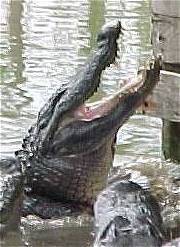Alligator attacks can kill your child
 Alligators are living dinosaurs that can be found in warm, wet areas of Texas, Mississippi, Louisiana, Alabama, Georgia, South Carolina, North Carolina and Florida. You can come into contact with alligators if you:
Alligators are living dinosaurs that can be found in warm, wet areas of Texas, Mississippi, Louisiana, Alabama, Georgia, South Carolina, North Carolina and Florida. You can come into contact with alligators if you:
- Live in an alligator-prone area, or
- Travel to an alligator-prone area on a family trip or a vacation. For example, if you go to Florida on vacation, be aware that Florida has over one million alligators.
The problem with alligators is that they are killing machines and they cannot be tamed. An alligator is as "wild" as a wild animal gets. A typical adult male alligator is 10 or 11 feet long and weighs about 600 pounds. Yet its brain weighs less than 10 grams -- it is about the size of a grape. Alligators are driven strictly by instinct.
Instinct tells a hungry alligator to kill and eat any living thing that moves. Alligators eat fish, turtles, frogs, birds and small or large mammals. Your child is a small mammal. Here is a typical scenario:
- An alligator is living in a pond.
- It lurks in the shadows along the pond's edge waiting for anything edible to come along. When it is lurking, an alligator will sit motionless with just its head an nostrils above the water, like this:

An alligator can remain motionless and alert in this position for hours and is invisible in the shadows.
- If a child happens to wander down to the water's edge, the alligator will strike with amazing speed. An alligator's jaws are huge and can exert 2,000 PSI of force.
- The alligator will drag the child to the bottom of the pond and drown the child.
- The alligator will then bring the child to the surface to eat the child.
Alligator attacks are fairly common. For example, here is a sampling of news articles:
If you live in an alligator-prone area or travel to a state like Florida on vacation, you need to be very conscious of alligators. In general, you never want your child to be near the water's edge or in the water in an area where there are alligators. Even with adult supervision, if a 600 pound alligator latches onto your child, there is very little an adult can do. You should be conscious of the alligator problem in any unfenced area near water (pond, lake, river, irrigation canal) in an alligator-prone area.
Additional Resources
 Alligators are living dinosaurs that can be found in warm, wet areas of Texas, Mississippi, Louisiana, Alabama, Georgia, South Carolina, North Carolina and Florida. You can come into contact with alligators if you:
Alligators are living dinosaurs that can be found in warm, wet areas of Texas, Mississippi, Louisiana, Alabama, Georgia, South Carolina, North Carolina and Florida. You can come into contact with alligators if you:
 Alligators are living dinosaurs that can be found in warm, wet areas of Texas, Mississippi, Louisiana, Alabama, Georgia, South Carolina, North Carolina and Florida. You can come into contact with alligators if you:
Alligators are living dinosaurs that can be found in warm, wet areas of Texas, Mississippi, Louisiana, Alabama, Georgia, South Carolina, North Carolina and Florida. You can come into contact with alligators if you:
